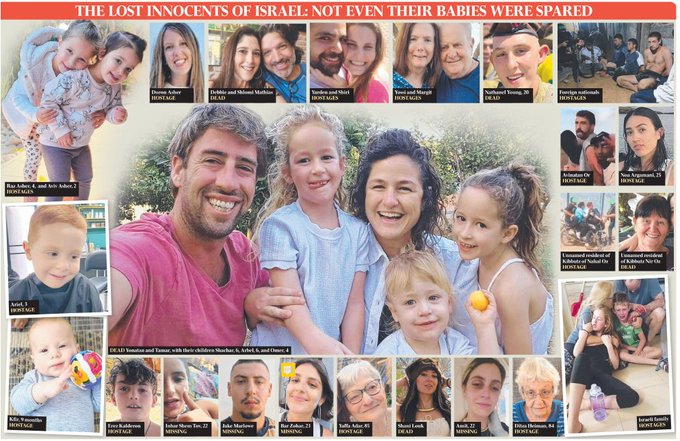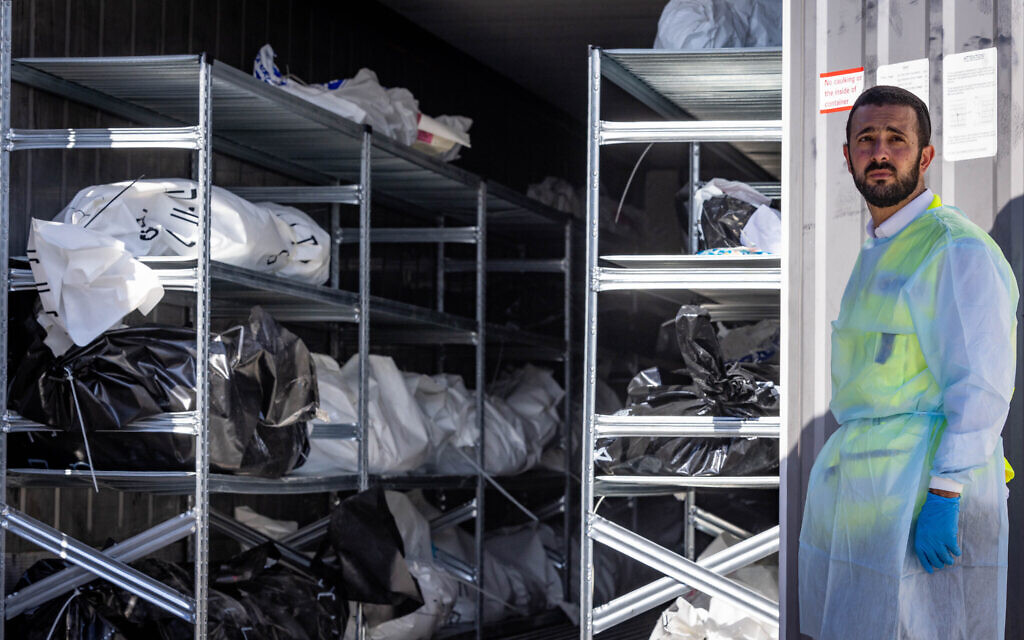RAMLE — Bodies are hauled in via refrigerated trucks, shrouded in thin white sheets or sealed in plastic bags, and unloaded in a quiet corner of the Military Rabbinate’s main base.
Overwhelming the permanent mortuary facilities, they are racked and loaded into a series of refrigerated containers, so they can be stored for processing and burial.
These are the unidentified bodies among the 1,300 Israelis, the vast majority of whom civilians, who were killed by Hamas during a devastating Saturday terror attack.
“We take the bodies of the murdered from the war,” explained A., a military officer responsible for overseeing the identification and processing operation. “Not everyone comes with identification, so we identify them with DNA, fingerprints, teeth records,” he said.
When asked if the facility processes the deceased through in-person family identifications, A. said a resolute “no.”
“It’s impossible to identify them after a while,” he added, declining to elaborate.

A Zaka volunteer stands in front of a refrigerator truck, serving as a temporary mortuary for victims of Hamas’ October 7 attack, at the Military Rabbinate’s headquarters in Ramle, October 13, 2023. (GPO)
“Some bodies are so mutilated,” said Josh Wander, a spokesperson for burial organization Zaka, who was on site alongside several Zaka volunteers helping the military to process the corpses.
Devastatingly numerous among the Hamas victims, children, Wander said, pose a specific identification challenge.
“Most people have fingerprints in a database — if they have biometric ID or a passport, from the army, or if they were arrested,” Wander explained.
“If for some reason they can’t do that because they’re children or the body is mutilated to the point of not being able to take fingerprints, they go through the process of DNA,” he continued.
DNA processing, he added, requires a longer identification timeframe, meaning more uncertainty for families.

A line of containers serving as a temporary mortuary for victims of Hamas’ October 7 attack, at the Military Rabbinate’s headquarters in Ramle, October 13, 2023. (GPO)
The Israel Defense Forces on Thursday announced that of the 854 civilian bodies that had been brought to the rabbinate, 361 have been identified and 264 buried.
In addition, the remains of 257 soldiers were identified, largely using fingerprints, dental records and dog tags. Not all of the soldiers killed in Saturday’s attack were active in the fighting, as many were killed off duty, particularly during Hamas’s massacre of a desert music festival near the town of Re’im.
Forty-eight police officers and 10 Shin Bet service members were also among the fallen, according to numbers released by their services. It is unclear if they are counted among the civilian deaths.
Hamas surprised Israel early on Saturday morning, overwhelming Israel’s Gaza border fence and infiltrating southern communities, a police station, a military base, and a music festival timed to coincide with the Jewish holiday of Simchat Torah, also celebrated last Saturday.

An aerial picture shows the abandoned site of the weekend attack on the Supernova desert music festival by Palestinian terrorists near Kibbutz Re’im in the Negev desert in southern Israel on October 10, 2023. (Jack GUEZ / AFP)
The terror organization filmed and released videos of its combatants committing atrocities and in their immediate aftermath, including rape, beheadings and torture.
In addition to over 1,300 Israeli dead and 3,300 wounded, an estimated 150 Israelis were kidnapped to the Gaza Strip, and are now being held hostage.
Israel, in response, quickly declared war against Gaza Strip terror organizations and embarked upon an airstrike campaign that has left 1,500 dead in Gaza, according to the Hamas-controlled health ministry. A breakout figure for combatants among the casualties was not released.
A further 1,500 Hamas terrorists were killed inside Israel, where fighting persisted for several days.





